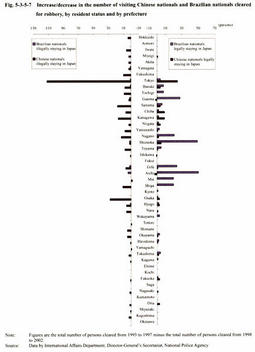| Previous Next Index Image Index Year Selection | |
|
|
3 Regional trends in foreign heinous offenders (1) Trends over the last 10 years Fig. 5-3-5-6 shows the number of visiting foreign nationals prosecuted or subjected to suspension of prosecution for heinous offenses over the 10 years from 1993 to 2002, which is divided in the first half (1993-1997) and the second half (1998-2002). As for homicide, the number was remarkably large in Tokyo and its neighboring prefectures. From the first half to the second half, the number declined slightly. As for robbery, the number was remarkably high in Tokyo, far beyond the level of homicide, accounting for about 40% of the total in Japan. The number was also large in prefectures around Tokyo, prefectures in the Tokai area such as Shizuoka and Aichi, and Osaka. The number increased in almost all prefectures from the first half to the second half, with significant increase seen in Tokyo (2.4-fold), Shizuoka (2.0-fold), Aichi (2.5-fold), and Osaka (4.1-fold). The number also increased in other prefectures, indicating that such upward trend is gradually spreading throughout Japan.
(2) Trends by nationality and resident status Fig. 5-3-5-7 shows the number of visiting Chinese nationals and Brazilian nationals cleared for robbery. Clearance of Chinese nationals and Brazilian nationals for robbery has recently been increasing significantly (top 2 nationalities), over the 10 years from 1993 to 2002, which is divided into the first half (from 1993 to 1997) and the second half (from 1998 to 2002), by resident status and by prefecture. As for Chinese nationals, the number of persons cleared was largest in Tokyo, with a remarkable increase over the 10 years. The increase in the number was also large in metropolitan areas including prefectures around Tokyo such as Kanagawa and Saitama as well as Osaka, and most of those cleared did not have resident status. As for Brazilian nationals, on the other hand, the increase in the number was large in the Tokai area including Aichi as well as Gunma, indicating a clear difference in the geographical distribution of increase/decrease compared with Chinese nationals. Such difference may be due to the fact that, as mentioned in Chapter 3, most visiting Chinese nationals cleared for robbery live in metropolitan areas as illegal arrivals (without valid passport) or are illegal overstayers whereas most visiting Brazilian nationals cleared for robbery settle down in local cities as legal arrivals or legal residents.
Fig. 5-3-5-6 Number of visiting foreign nationals prosecuted or subjected to the suspension of prosecution for homicide and robbery, by prefecture (1993-2002) Fig. 5-3-5-7 Increase/decrease in the number of visiting Chinese nationals and Brazilian nationals cleared for robbery, by resident status and by prefecture |

